Hyundai Staria vs Nissan Interstar – Differences & prices compared
Compare performance, boot space, consumption and price in one view.
Find out now: which car is the better choice for you – Hyundai Staria or Nissan Interstar?
The Hyundai Staria (Bus) comes with a Full Hybrid engine and Automatic transmission. In comparison, the Nissan Interstar (Cargo Van) features a Diesel or Electric engine with Manuel or Automatic transmission.
When it comes to boot capacity, the Hyundai Staria offers 831 L, while the Nissan Interstar provides – depending on how much space you need. If you’re looking for more power, decide whether the 225 HP of the Hyundai Staria or the 170 HP of the Nissan Interstar suits your needs better.
In terms of consumption, the values are 7.60 L per 100 km for the Hyundai Staria, and 7.40 L for the Nissan Interstar.
Price-wise, the Hyundai Staria starts at 42400 £, while the Nissan Interstar is available from 34900 £. Compare all the details and find out which model fits your lifestyle best!
Hyundai Staria
The Hyundai Staria stands out with its futuristic design, characterised by sleek lines and an expansive front grille that makes a bold statement on the road. Inside, it offers a spacious and versatile interior, providing a comfortable ride for both driver and passengers. This vehicle effortlessly combines practicality with a touch of luxury, appealing to families and professionals alike.
details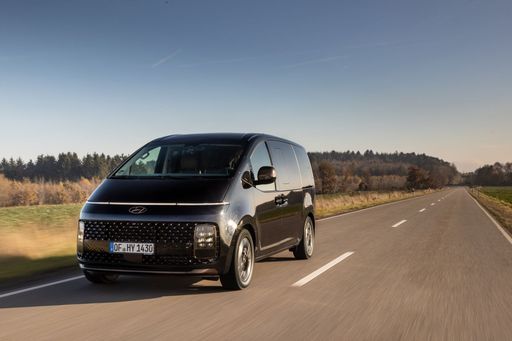 @ hyundai.news
@ hyundai.news
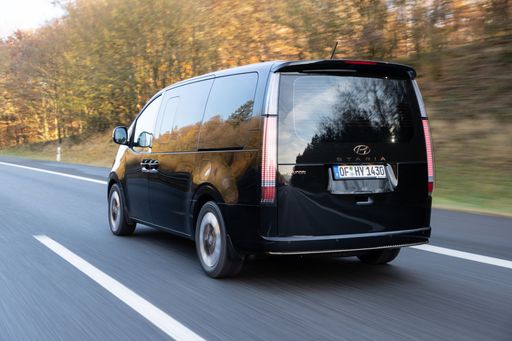 @ hyundai.news
@ hyundai.news
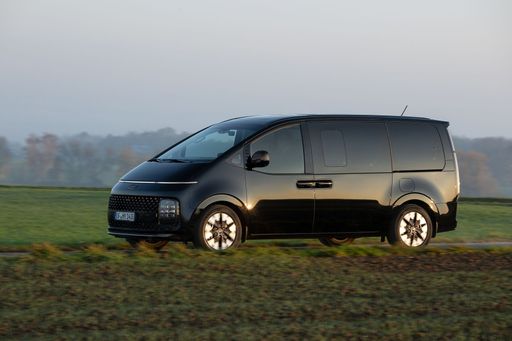 @ hyundai.news
@ hyundai.news
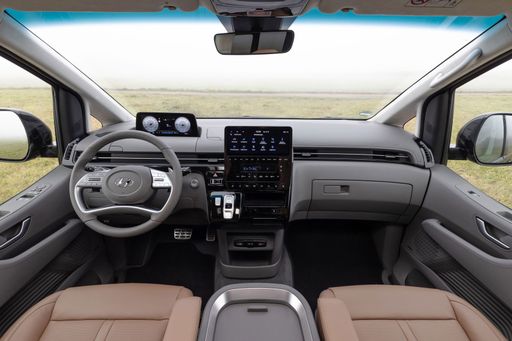 @ hyundai.news
@ hyundai.news
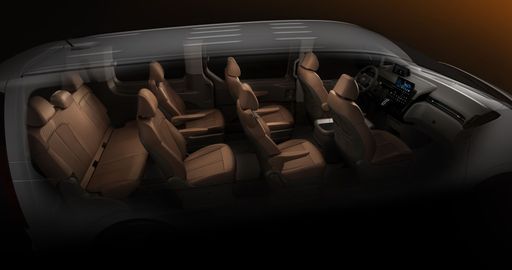 @ hyundai.news
@ hyundai.news
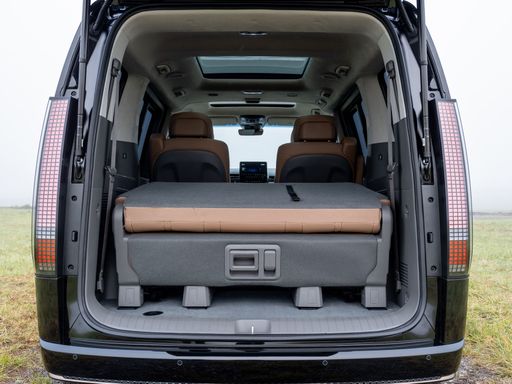 @ hyundai.news
@ hyundai.news
Nissan Interstar
The Nissan Interstar is a versatile van that expertly combines practicality with modern design. It offers a spacious interior that caters to both cargo and passenger needs, making it ideal for businesses and families alike. With its robust performance and efficient fuel consumption, the Interstar stands out as a reliable choice in the commercial vehicle market.
details

|
|
|
|
|
Costs and Consumption |
|
|---|---|
|
Price
42400 - 50500 £
|
Price
34900 - 55600 £
|
|
Consumption L/100km
7.60 L
|
Consumption L/100km
7.4 - 7.5 L
|
|
Consumption kWh/100km
-
|
Consumption kWh/100km
-
|
|
Electric Range
-
|
Electric Range
175 - 410 km
|
|
Battery Capacity
-
|
Battery Capacity
-
|
|
co2
172 g/km
|
co2
0 - 195 g/km
|
|
Fuel tank capacity
65 L
|
Fuel tank capacity
80 L
|
Dimensions and Body |
|
|---|---|
|
Body Type
Bus
|
Body Type
Cargo Van
|
|
Seats
7 - 9
|
Seats
3 - 7
|
|
Doors
5
|
Doors
4
|
|
Curb weight
2275 - 2345 kg
|
Curb weight
2053 - 2535 kg
|
|
Trunk capacity
117 - 831 L
|
Trunk capacity
-
|
|
Length
5253 mm
|
Length
5680 - 6315 mm
|
|
Width
1997 mm
|
Width
2080 mm
|
|
Height
1990 mm
|
Height
2498 - 2756 mm
|
|
Payload
605 - 775 kg
|
Payload
965 - 1447 kg
|
Engine and Performance |
|
|---|---|
|
Engine Type
Full Hybrid
|
Engine Type
Diesel, Electric
|
|
Transmission
Automatic
|
Transmission
Manuel, Automatic
|
|
Transmission Detail
Automatic Gearbox
|
Transmission Detail
Manual Gearbox, Automatic Gearbox, Reduction Gearbox
|
|
Drive Type
Front-Wheel Drive
|
Drive Type
Front-Wheel Drive
|
|
Power HP
225 HP
|
Power HP
105 - 170 HP
|
|
Acceleration 0-100km/h
10.20 s
|
Acceleration 0-100km/h
-
|
|
Max Speed
167 km/h
|
Max Speed
115 - 177 km/h
|
|
Torque
367 Nm
|
Torque
300 - 380 Nm
|
|
Number of Cylinders
4
|
Number of Cylinders
4
|
|
Power kW
165 kW
|
Power kW
77 - 125 kW
|
|
Engine capacity
1598 cm3
|
Engine capacity
1997 cm3
|
General |
|
|---|---|
|
Model Year
2024
|
Model Year
2024 - 2025
|
|
CO2 Efficiency Class
F
|
CO2 Efficiency Class
G, A
|
|
Brand
Hyundai
|
Brand
Nissan
|
Hyundai Staria
A Bold New Horizon: The Hyundai Staria
The Hyundai Staria is redefining the landscape of family vehicles, blending technological innovation with exceptional design. As a groundbreaking multi-purpose vehicle (MPV), it offers a unique balance of style, comfort, and performance. This article delves into the impressive technical details and cutting-edge features that elevate the Staria above its peers.
Cutting-Edge Design & Spacious Comfort
The first thing you’ll notice about the Hyundai Staria is its futuristic design. With a length of 5253 mm, a width of 1997 mm, and a height of 1990 mm, the Staria stands out with its imposing presence. Its sleek silhouette is complemented by wide panoramic windows that enhance visibility and give passengers a sense of space, further underscored by a class-leading interior height.
The Staria is available in configurations that can accommodate between seven to nine seats, offering flexibility for families and businesses alike. Additionally, it boasts a spacious boot with 117 to 831 litres of cargo space, ensuring ample room for luggage and more.
Powertrain and Performance
Under the bonnet of the Hyundai Staria lies a robust 2.2 CRDi diesel engine. Generating an impressive 177 PS (130 kW) and a maximum torque of 430 Nm, this 4-cylinder engine provides strong and consistent performance. It is paired with an automatic transmission that ensures smooth gear shifts, available in both all-wheel and front-wheel drive configurations.
The Staria delivers on efficiency too, with fuel consumption ranging from 8.5 to 8.9 litres per 100 km. It accelerates from 0-100 km/h in 12.4 to 13.5 seconds, with a top speed between 180 to 185 km/h, making it a versatile choice for city and highway driving alike.
Advanced Safety and Technology
Hyundai has packed the Staria with an array of advanced safety features. From intelligent driver assistance systems to cutting-edge connectivity options, the Staria ensures that both driver and passengers are protected and entertained. With its CO2 efficiency class rated at G and CO2 emissions ranging from 222 to 232 g/km, it strikes a balance between performance and environmental considerations.
Conclusion: More Than Just a Vehicle
The Hyundai Staria is more than a mode of transport; it represents a new era in vehicle design and functionality. With prices ranging from €48,100 to €59,600, it provides consumers with a wide array of premium features typically associated with higher-end models. Whether for family adventures or business needs, the Staria assures a drive defined by comfort, innovation, and style.
The Staria sets a new benchmark in the MPV sector, offering a glimpse into the future of automotive versatility and sophistication.
Nissan Interstar
The Evolution of the Nissan Interstar
The Nissan Interstar has long been a staple in the commercial vehicle sector, known for its robust build and practical design. The latest iterations have further cemented its status with a range of technical enhancements and innovative features aimed at aiding businesses in achieving optimal efficiency. Whether you're navigating city streets or traversing the highways, the Interstar stands out as a reliable workhorse ready to meet various transport needs.
Power and Performance
The current range of Nissan Interstar models boasts diesel engines ranging from 105 to 180 PS, offering a commendable blend of power and fuel efficiency across the board. With a fuel consumption of between 7.4 and 7.5 litres per 100 kilometres, these vehicles are designed to minimise operational costs while maximizing performance.
All models feature four-cylinder engines, with engine displacement between 1997 and 2299 cm³, capable of producing torque figures between 330 and 400 Nm. These specifications ensure that the Interstar offers superior pulling power, which is particularly useful for transporting heavy loads across different terrains.
Transmission and Drive Options
Versatility is at the heart of the Nissan Interstar, with transmission options including both manual and automatic gearboxes. Drivers can also choose between front-wheel and rear-wheel drive configurations, allowing the vehicle to suit specific logistical requirements or personal preferences.
For those seeking simplicity and ease of use in urban environments, the Interstar with its automated gearshift provides a smooth driving experience, reducing driver fatigue and increasing focus on the road ahead.
Dimensions and Load Capacities
The Nissan Interstar is available in various lengths, from 5048 mm to an extensive 6848 mm, catering to diverse commercial needs. With widths ranging from 2070 mm to 2222 mm and heights from 2307 mm to 2808 mm, the Interstar offers multiple configurations to maximise cargo space and accommodate various loads.
With a maximum payload capacity of up to 1451 kg, businesses can rest assured that the Interstar is more than capable of delivering goods efficiently without compromising on safety or comfort.
Innovation and Technological Features
While functionality remains a priority, Nissan has not skimped on technological advancements. Among the innovations included are advanced safety features, such as anti-lock braking systems (ABS), electronic stability control (ESC), and a variety of sensors to assist with parking and reversing.
In terms of driver comfort, the brand offers multiple trim levels with exceptional interior features designed to enhance driver experience during long hauls. Options such as climate control, advanced navigation systems, and modern infotainment setups are available, ensuring that both driver and passenger remain comfortable and connected, regardless of the journey length.
Coachwork and Trim Options
The Interstar line-up provides a range of trim levels and equipment lines, from the entry-level Visia to the high-spec Tekna, catering to different market demands and individual preferences. The selection allows buyers to prioritise features that best suit their operation or driving style.
For example, the N-CONNECTA variant offers an array of added extras, enhancing both connectivity and comfort for drivers who rely on the vehicle as a mobile office.
Conclusion
The Nissan Interstar represents a harmonious blend of power, efficiency, and technological innovation in the large van segment. With its vast array of options and features, the Interstar is undeniably a top choice for businesses looking to invest in a dependable and adaptable commercial vehicle. As the line-up continues to evolve, the Interstar remains poised to meet the growing challenges and demands of the modern logistic landscape.
Which drive types are available for the Hyundai Staria?
Available as Front-Wheel Drive.
The prices and data displayed are estimates based on German list prices and may vary by country. This information is not legally binding.
